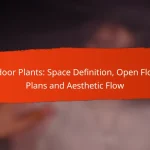Indoor plants can be susceptible to a variety of pests, including small insects and mites that threaten their health by feeding on sap or transmitting diseases. Early identification of these pests is essential for implementing effective management and prevention strategies to protect your plants. By recognizing signs of infestation and employing targeted treatments, you can maintain a thriving indoor garden.
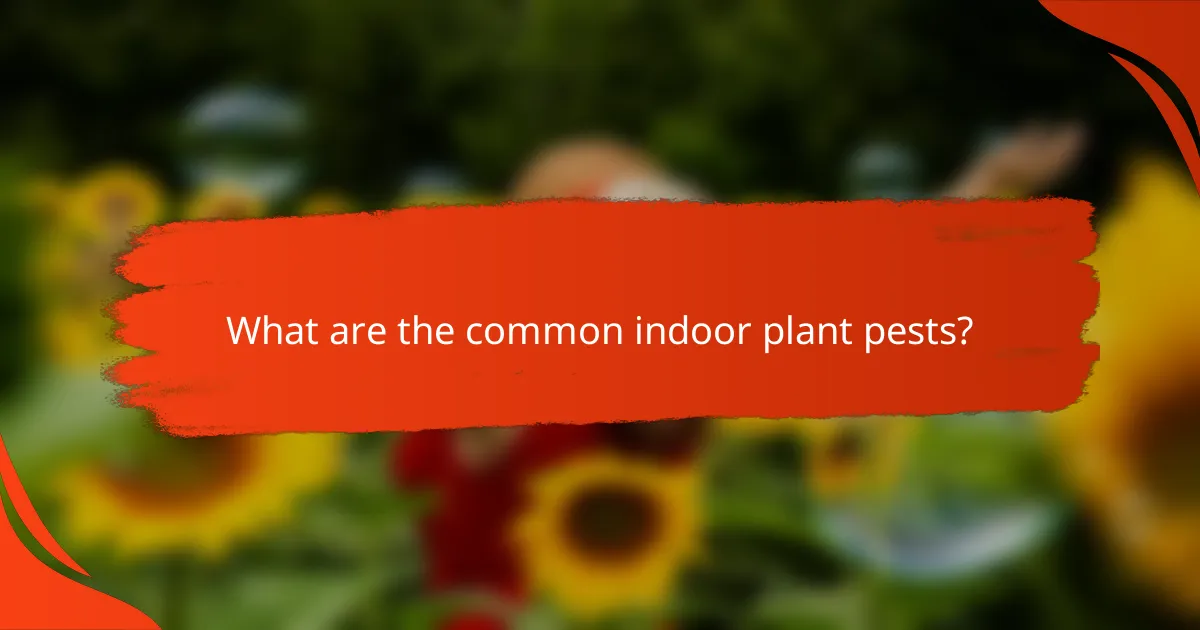
What are the common indoor plant pests?
Common indoor plant pests include small insects and mites that can damage plants by feeding on their sap or causing disease. Identifying these pests early is crucial for effective management and prevention strategies.
Aphids
Aphids are small, soft-bodied insects that often cluster on new growth and undersides of leaves. They can be green, black, or brown and reproduce quickly, leading to significant infestations if not controlled.
To manage aphids, consider using insecticidal soap or neem oil, which can effectively eliminate them without harming beneficial insects. Regularly inspecting plants and removing any visible clusters can help prevent larger outbreaks.
Spider mites
Spider mites are tiny arachnids that thrive in dry conditions and can cause yellowing leaves and webbing on plants. They are often difficult to see but can be identified by the fine webs they produce.
To control spider mites, increase humidity around your plants and use miticides or insecticidal soap. Regularly misting plants can also deter these pests, as they prefer dry environments.
Mealybugs
Mealybugs are small, white, cottony insects that typically hide in leaf axils and on stems. They feed on plant sap and can weaken plants significantly if left untreated.
To manage mealybugs, dab them with a cotton swab soaked in alcohol to kill them on contact. Systemic insecticides can also be effective for severe infestations, but ensure to follow label instructions for safe use.
Whiteflies
Whiteflies are small, white insects that fly up when plants are disturbed. They feed on the underside of leaves, causing yellowing and stunted growth.
Controlling whiteflies involves using yellow sticky traps to catch adults and applying insecticidal soap or horticultural oil to the affected plants. Regular monitoring can help catch infestations early.
Fungus gnats
Fungus gnats are small, dark flies that are often found in the soil of potted plants. Their larvae feed on organic matter and can damage plant roots, leading to poor growth.
To manage fungus gnats, allow the soil to dry out between waterings, as they thrive in moist conditions. You can also use sticky traps to catch adult gnats and beneficial nematodes to target larvae in the soil.
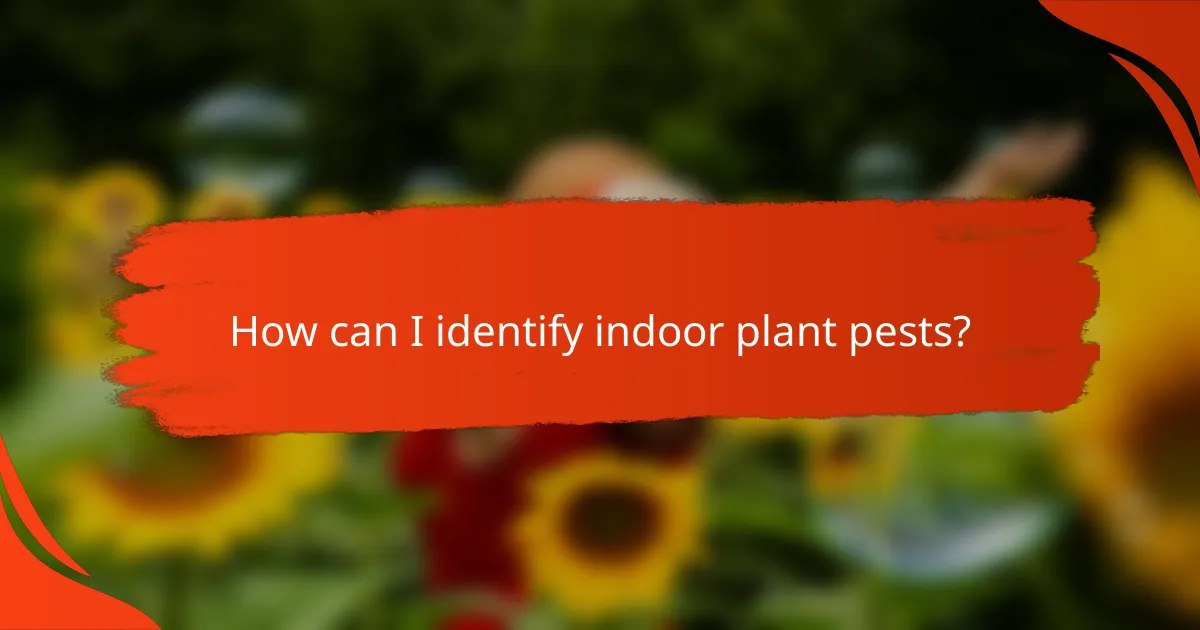
How can I identify indoor plant pests?
Identifying indoor plant pests involves recognizing specific signs of infestation and employing visual techniques to spot them. Early detection is crucial for effective management and prevention of damage to your plants.
Signs of infestation
Common signs of pest infestations include yellowing leaves, visible insects, webbing, and sticky residue on leaves. Look for discolored spots or holes in the foliage, which can indicate feeding damage from pests.
Additionally, you might notice a decrease in plant growth or wilting, which can be symptoms of stress caused by pests. Regularly inspecting your plants will help you catch these signs early.
Visual identification techniques
To visually identify pests, examine your plants closely, especially the undersides of leaves and leaf joints, where many pests hide. Use a magnifying glass for better visibility of small insects like aphids or spider mites.
Familiarize yourself with common pests such as mealybugs, scale, and thrips by comparing them to online resources or pest identification guides. Keeping a reference image handy can aid in quick identification.
Using sticky traps
Sticky traps are an effective tool for monitoring pest populations. Place yellow or blue sticky traps near your plants to attract flying insects like fungus gnats and whiteflies. Regularly check these traps to assess the level of infestation.
When using sticky traps, position them at different heights to catch various pests. Replace traps as needed to maintain their effectiveness, ensuring you have a clear picture of any pest issues in your indoor garden.
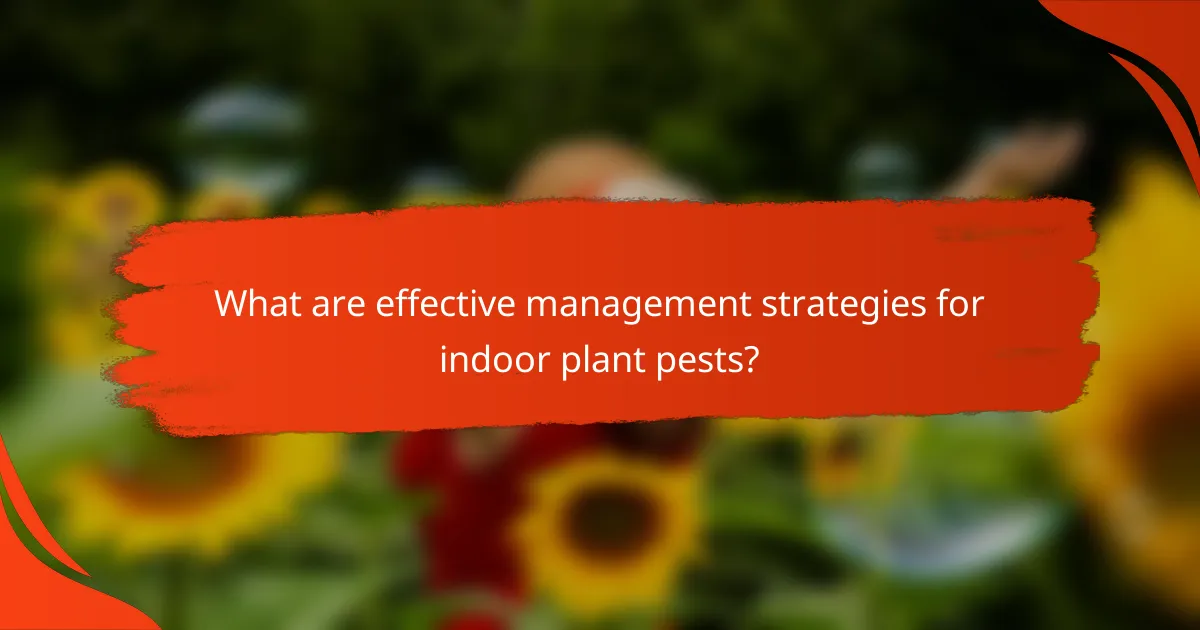
What are effective management strategies for indoor plant pests?
Effective management strategies for indoor plant pests include using insecticidal soaps, neem oil treatments, beneficial insects, and physical removal methods. Each approach has its own benefits and considerations, allowing for tailored solutions based on the specific pest problem and plant type.
Insecticidal soaps
Insecticidal soaps are a popular choice for managing indoor plant pests like aphids and spider mites. These soaps work by suffocating the pests and disrupting their cell membranes, making them effective yet gentle on plants.
When using insecticidal soaps, ensure that the product is specifically labeled for indoor use and follow the application instructions carefully. It’s best to apply the soap in the early morning or late evening to avoid direct sunlight, which can cause plant damage.
Neem oil treatments
Neem oil is derived from the seeds of the neem tree and acts as both a pesticide and a fungicide. It disrupts the life cycle of pests, making it effective against a variety of insects, including whiteflies and mealybugs.
To use neem oil, dilute it according to the manufacturer’s instructions and spray it on affected plants. Regular applications every few weeks can help prevent infestations. Be cautious with sensitive plants, as neem oil can cause leaf burn if used excessively.
Beneficial insects
Introducing beneficial insects, such as ladybugs and lacewings, can naturally control pest populations in indoor gardens. These insects prey on common pests, providing a biological control method that reduces the need for chemical treatments.
When using beneficial insects, ensure that your indoor environment can support their survival. This may involve providing food sources, such as pollen or nectar, and maintaining appropriate humidity levels to keep them thriving.
Physical removal methods
Physical removal methods include manually picking off pests or using sticky traps to catch flying insects. These methods are straightforward and can be effective for small infestations.
For best results, inspect your plants regularly and remove any visible pests promptly. Sticky traps can be placed near affected plants to monitor pest activity and help reduce populations without chemicals.
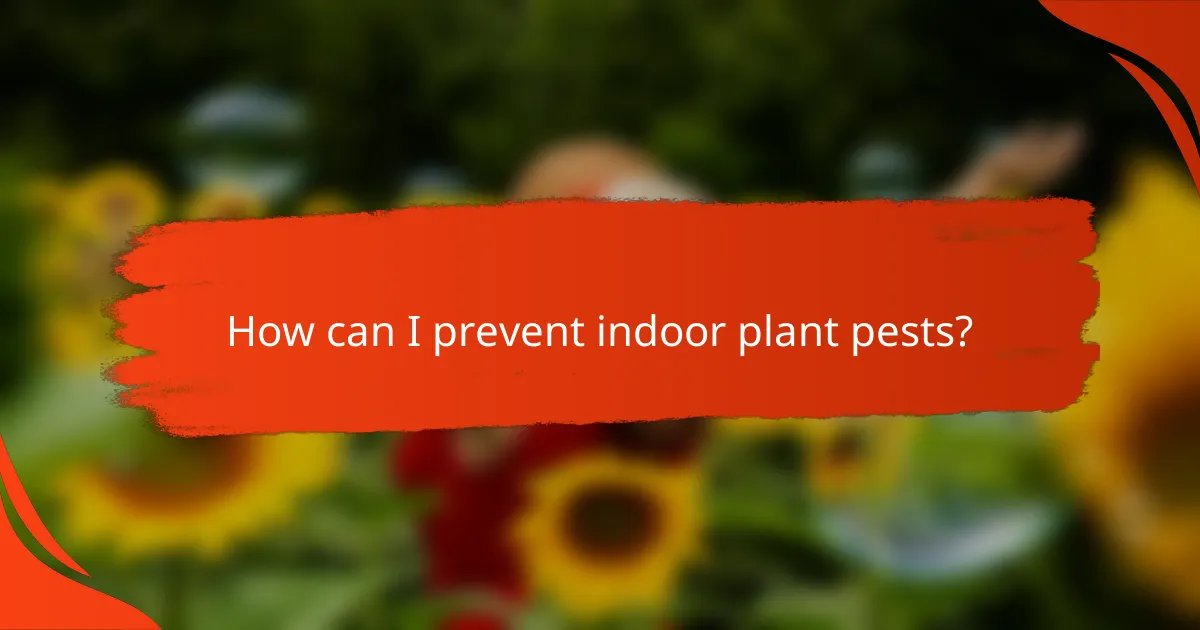
How can I prevent indoor plant pests?
Preventing indoor plant pests involves regular monitoring, proper care, and strategic practices. By implementing these measures, you can significantly reduce the risk of infestations and maintain healthy plants.
Regular plant inspections
Conducting regular inspections of your indoor plants is crucial for early pest detection. Check the leaves, stems, and soil for any signs of pests or damage, ideally once a week. Look for discolored spots, webbing, or small insects.
If you notice any issues, take immediate action to address them. Removing affected leaves or using insecticidal soap can help manage minor infestations before they escalate.
Proper watering techniques
Proper watering is essential in preventing pests, as overwatering can create a damp environment conducive to pests like fungus gnats. Water your plants only when the top inch of soil feels dry to the touch, ensuring good drainage to avoid standing water.
Consider using pots with drainage holes and self-watering systems to maintain optimal moisture levels. This not only helps prevent pests but also promotes healthier root systems.
Quarantine new plants
Quarantining new plants before introducing them to your existing collection is a vital step in pest prevention. Keep new arrivals in a separate area for at least two weeks to monitor for any signs of pests or diseases.
During this period, inspect the new plants regularly and treat any issues before they can spread. This practice can save your entire indoor garden from potential infestations.
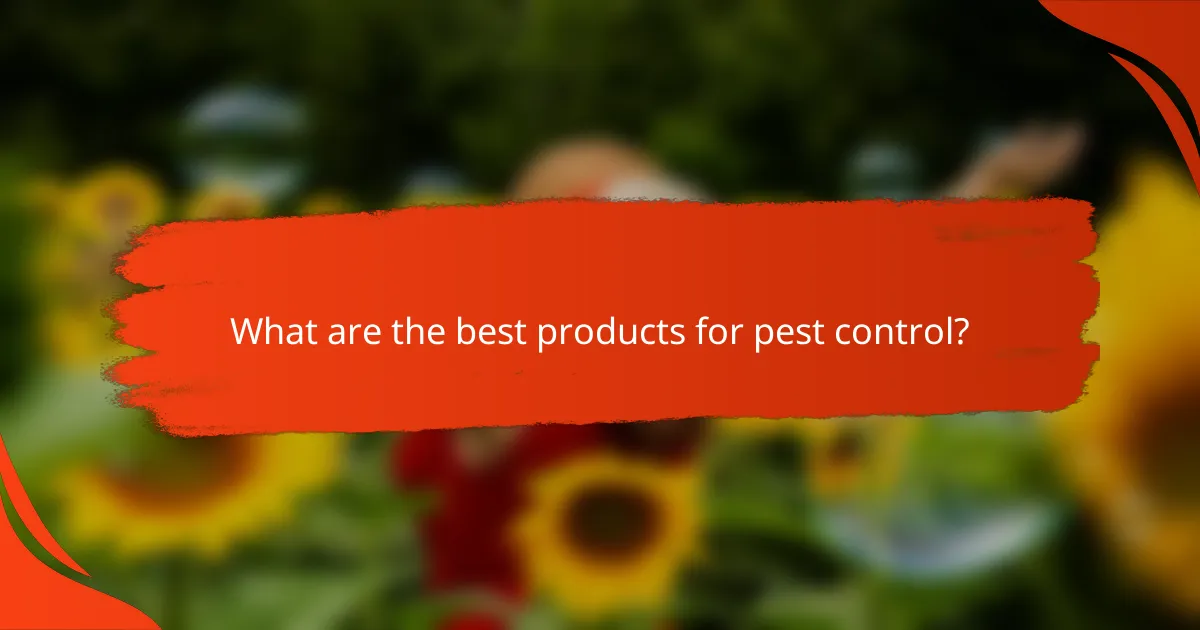
What are the best products for pest control?
The best products for pest control in indoor plants include insecticidal soaps, neem oil, and sticky traps. These options are effective, easy to use, and generally safe for both plants and humans.
Bonide Insecticidal Soap
Bonide Insecticidal Soap is a popular choice for controlling soft-bodied pests like aphids and spider mites. It works by suffocating insects on contact, making it crucial to thoroughly cover the affected areas of your plants.
When using Bonide, apply it during cooler parts of the day to prevent leaf burn. Reapply every 7-10 days until the pest problem is resolved. Always test on a small area first to ensure your plants tolerate the treatment.
Safer Brand Neem Oil
Safer Brand Neem Oil is derived from the seeds of the neem tree and is effective against a variety of pests, including whiteflies and mealybugs. It disrupts the life cycle of insects, making it a long-term solution for pest management.
Mix neem oil with water according to the instructions and spray on affected plants every 7-14 days. Avoid using it in direct sunlight to prevent damage to the foliage. This product is also beneficial for promoting overall plant health.
Sticky traps by Gideal
Sticky traps by Gideal are an excellent non-toxic option for monitoring and controlling flying pests like fungus gnats and whiteflies. These bright yellow traps attract insects, which then stick to the surface, preventing them from reproducing.
Place the traps near the base of your plants or hang them where pests are most active. Replace the traps as they become full or every few weeks to maintain their effectiveness. This method is particularly useful for early detection of infestations.
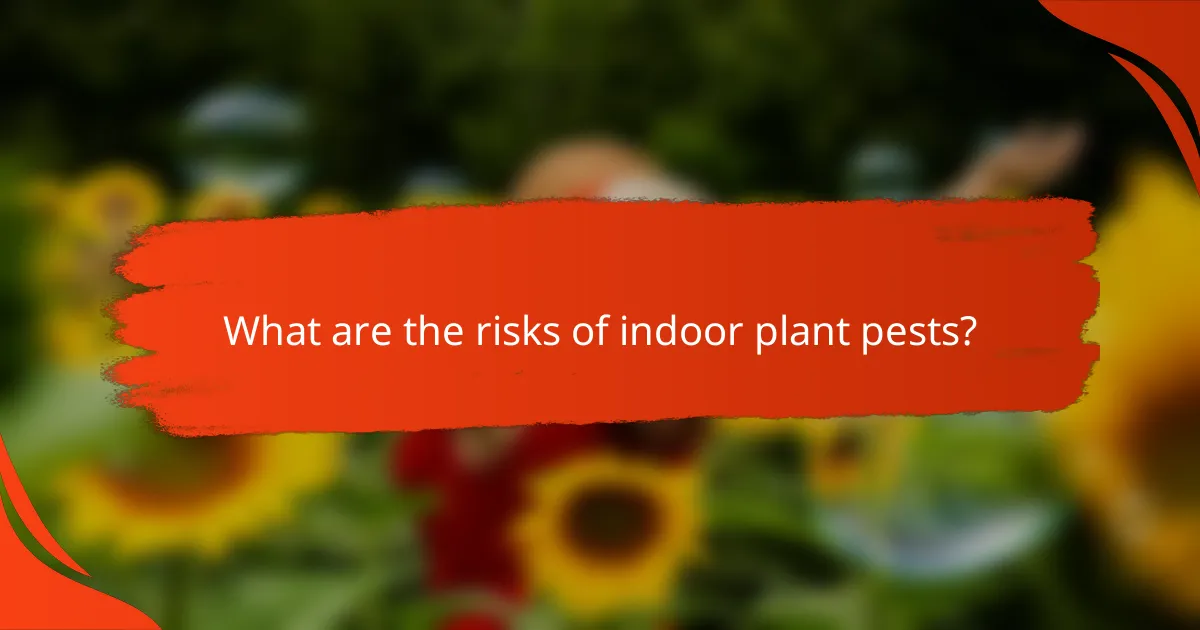
What are the risks of indoor plant pests?
Indoor plant pests can cause significant damage to your plants, leading to poor health or even death. They can also spread diseases and infestations to other plants in your home, creating a larger problem.
Common types of indoor plant pests
Common indoor plant pests include aphids, spider mites, mealybugs, and fungus gnats. Each of these pests has unique characteristics and behaviors, making identification crucial for effective management.
Aphids are small, soft-bodied insects that often cluster on new growth, while spider mites are tiny arachnids that create fine webs on the undersides of leaves. Mealybugs appear as white, cottony masses on stems and leaves, and fungus gnats are small flies that thrive in moist soil.
Signs of infestation
Signs of pest infestation can vary but often include discolored leaves, visible insects, webbing, or sticky residue on plants. Yellowing or wilting leaves may indicate a problem, as well as small holes or spots on foliage.
Regularly inspecting your plants can help catch infestations early. Look for any unusual growth patterns or the presence of pests, especially on the undersides of leaves where they tend to hide.
Management strategies
Effective management of indoor plant pests involves a combination of physical removal, chemical treatments, and cultural practices. Start by manually removing pests with a damp cloth or by rinsing plants with water.
If infestations are severe, consider using insecticidal soap or neem oil, which are generally safe for indoor use. Always follow the manufacturer’s instructions and test any treatment on a small area first.
Prevention tips
Preventing indoor plant pests requires maintaining healthy plants and proper care routines. Ensure your plants are not overwatered, as excess moisture can attract pests like fungus gnats.
Regularly cleaning your plants and their surroundings can also deter pests. Quarantine new plants for a few weeks before introducing them to your collection to avoid bringing in unwanted pests.

